by A. Wayne Ferens
Photos from the Ferens Collection, Dave Friedman Collection, Robert Walker Collection, and Lynn Park Collection
Published 12.27.2023
By Robert Tate, Automotive Historian and Researcher
Images Courtesy of Ford Motor Company Archives
Published 12.20.2023
By Robert Tate, Automotive Historian and Researcher
Images courtesy of Tom Hale/Automotive Illustrations
Published 12.13.2023
Read more: Tom Hale: A Gifted and Talented Automotive Artist
By Robert Tate, Automotive Historian and Researcher
Images Courtesy of Chrysler Archives and the Robert Tate Collection
Published 12.6.2023
By Jeffrey D. Brasie
Images Courtesy of the Author
Published 11.29.2023
Read more: The Buick Reatta: Short-Lived -- But a Legendary Design
By Robert Tate, Automotive Historian and Researcher
Images Courtesy of GM Media Archives
Published 11.22.2023
Read more: The 1958 Chevrolet Impala was a Great Looking & Popular Car
By Robert Tate, Automotive Historian and Researcher
Images Courtesy of the Chrysler Archives and Walter P. Reuther Library
Published 11.15.2023
Read more: Remembering the Great Automotive Legacy of Charles W. Nash
By Robert Tate, Automotive Historian and Researcher
Images Courtesy of Cragar Industries/Gary Gabelich Blue Flame Rocket Engine
Published 11.8.2023
by A. Wayne Ferens
Images Courtesy of Ford Motor Company Archives, Wayne Ferens Collection
Published 11.1.2023
By Robert Tate, Automotive Historian and Researcher
Images Courtesy of General Motors Media Archives
Published 10.25.2023
Read more: Remembering the 1957 Chevy Corvette & Super Sport Show Car
By Robert Tate, Automotive Historian and Researcher
Images Courtesy of R.M Sotheby’s Car Auctions and The Robert Tate Collection
Published 10.18.2023
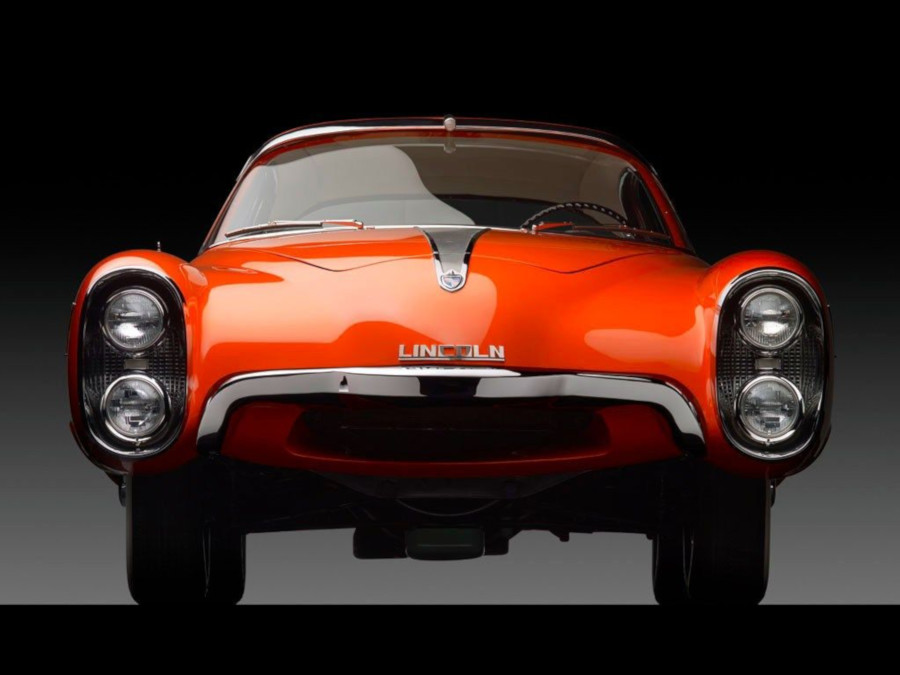 The front end of the 1955 Lincoln Indianapolis concept car (R.M. Sotheby)
The front end of the 1955 Lincoln Indianapolis concept car (R.M. Sotheby)
For many years, show cars have represented a vision of the future for automakers, with designs showing where they were thinking for new and upcoming models.
In 1955, the Lincoln Indianapolis show car made its debut at the Turin, (Italy) Automobile Salon as a unique and different automobile design. Today, the car is a mostly forgotten design.
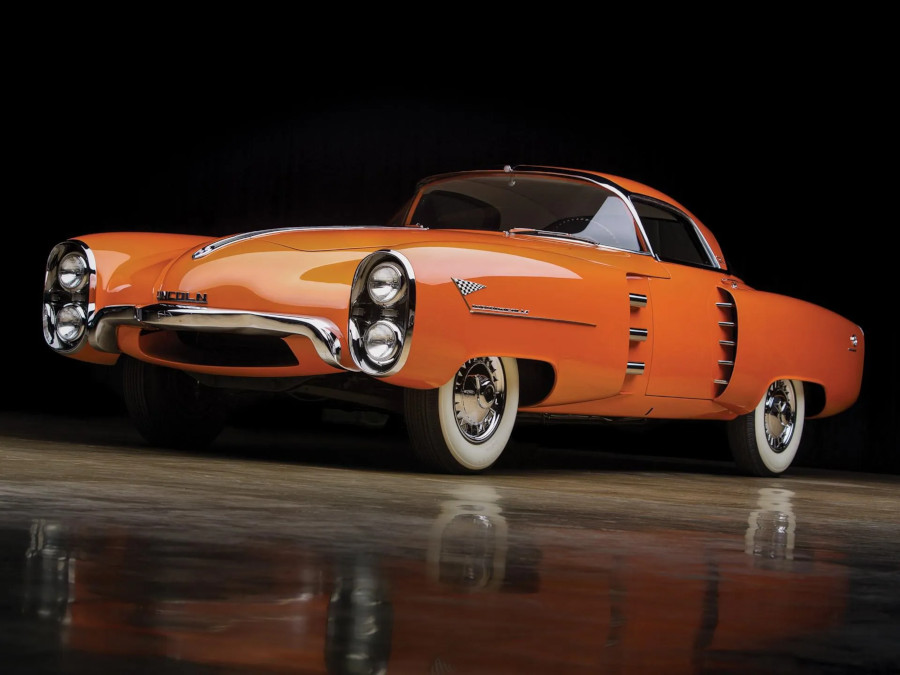 The 1955 Lincoln Indianapolis concept car (R.M Sotheby Car Auction)
The 1955 Lincoln Indianapolis concept car (R.M Sotheby Car Auction)
The Lincoln Indianapolis show car was designed in collaboration with Carrozeria Boano Turino. Ford Motor Company’s design team had nothing to do with the vehicle, as the styling was commissioned to Italian Fiat designer Gian Paolo Boano, who had also coined the concept vehicle’s American-sounding name. Because of this, many automotive historians have said that, in no way was it a Lincoln show car.
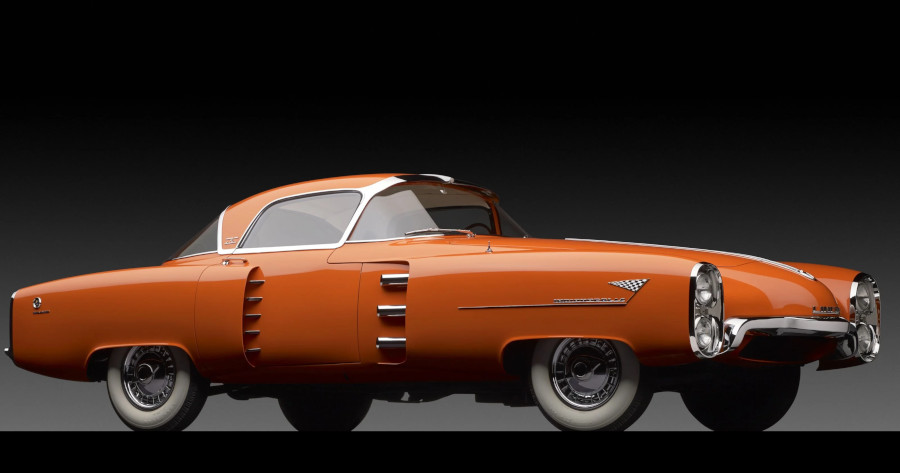 Another view of the 1955 Lincoln Indianapolis concept car (R.M. Sotheby car auction)
Another view of the 1955 Lincoln Indianapolis concept car (R.M. Sotheby car auction)
The 1955 Lincoln Indianapolis was designed to compete with jet age and Buck Rogers-esque space age designs unveiled during the 1950s. The project began with a Lincoln chassis provided by Ford CEO Henry Ford II. The styling featured a jet aircraft look with its pointed nose, rear fenders, great looking fender intakes, and those high marked fins. The interior was designed for two people with leather bucket seats and a divided console. This futurist streamlined aircraft-like design was supposed to represent 1930s Le Mans racing cars. However, I don’t think that worked out.
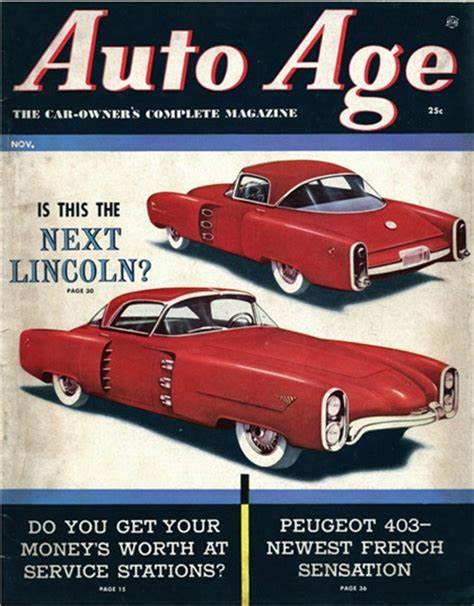 A 1955 issue of Auto Age Magazine (Robert Tate Collection)
A 1955 issue of Auto Age Magazine (Robert Tate Collection)
The Indianapolis show car had some success with the Turin show, and a 1955 issue of Auto Age magazine put the car on its cover with the question “Is this the next Lincoln?”
Some auto enthusiasts did not like the 1955 Lincoln Indianapolis show car, and historians have said the model left much to be desired. Some did not like the orange paint color finish, along with the front end and hood design. Ultimately, this was not the future design for Lincoln production as the 50s continued.
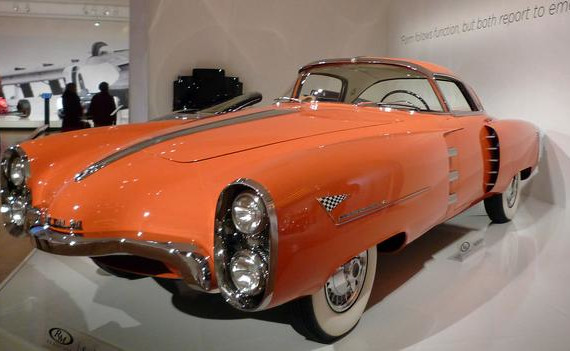 The 1955 Lincoln Indianapolis on display in a museum (R.M. Sotheby car auction)
The 1955 Lincoln Indianapolis on display in a museum (R.M. Sotheby car auction)
After Henry Ford II purchased the 1955 Lincoln Indianapolis concept car, it was later sold to Thomas Kerr, a prominent Packard collector. Kerr looked to undertake a total restoration project for the car, which included the engine and body enhancements as well. Some automotive historians have reported that the restoration led to numerous awards at prestigious events around the country, like the Pebble Beach Concours d’ Elegance and the Greenwich Concours.
 A glance at the 1955 Lincoln Indianapolis concept car's interior (R.M. Sotheby car auction)
A glance at the 1955 Lincoln Indianapolis concept car's interior (R.M. Sotheby car auction)
The 1955 Lincoln Indianapolis concept car had many owners over the years. When it was part of the Andrews Collection, it was displayed at various automotive museums. The car was also a part of the Automotive Renaissance collection for a time.
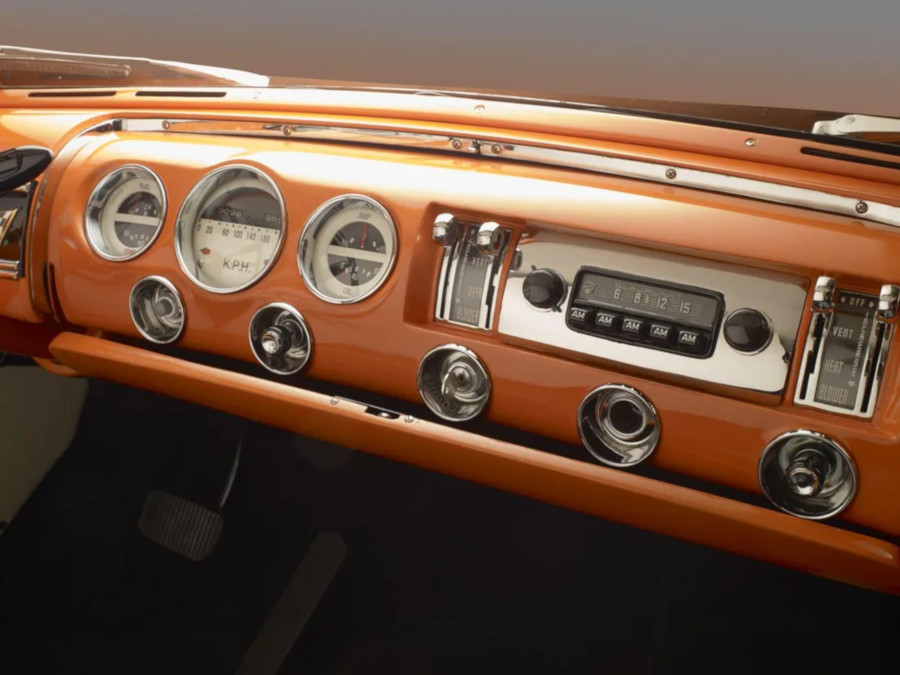 A view of the 1955 Lincoln Indianapolis interior panel (R.M. Sotheby car auction)
A view of the 1955 Lincoln Indianapolis interior panel (R.M. Sotheby car auction)
In 2013, the fully restored 1955 Lincoln Indianapolis concept car sold for $1.21 million dollars at RM’s Andrew Collection sale in Fort Worth, Texas.
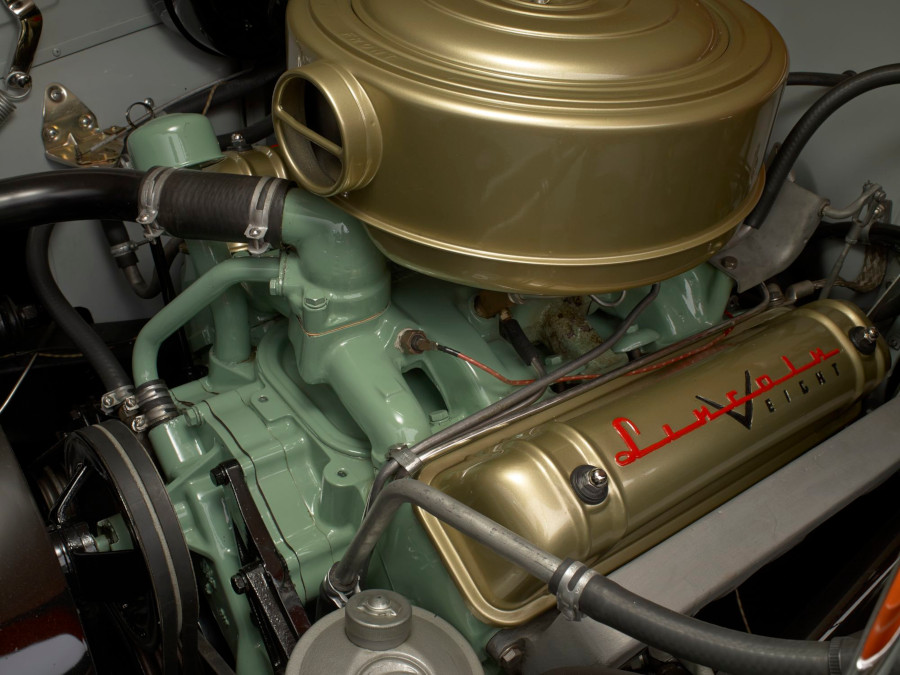 A look at the engine of the 1955 Lincoln Indianapolis concept car (R.M. Sotheby)
A look at the engine of the 1955 Lincoln Indianapolis concept car (R.M. Sotheby)
In conclusion, Lincoln Indianapolis concept car was introduced to the public in 1955. Featuring a stacked head light design, it was a car that automotive enthusiasts would not talk about for many years. However, this concept is still an intriguing part of our auto history.
Ernst, Kurt. “Straight from Pebble Beach: Lincoln Indianapolis Boano Coupe Heads to Auction.” Hemmings.com, September 13, 2013.
Newton, Andrew. “Sadly, This Gorgeous 1955 Lincoln Indianapolis was Only a Pawn.” Hagerty Media Car Profiles, July 19, 2019.
Auto Age Magazine. “Henry Ford Boano Lincoln.” November 1955.
By Robert Tate, Automotive Historian and Researcher
Images Courtesy of GM Media Archives, Wallpaper.com
Published 10.11.2023
Read more: The 1969 Pontiac GTO Judge Was a Great Looking Muscle Car
by Bob Sadler, MotorCities Director of Communications
Photos by Bob Sadler, the Robert Tate Collection and the Automotive Hall of Fame
Published 10.4.2023
Read more: Robert Tate Exhibit: An Appropriate Salute to a Trailblazer
by Brian Yopp, Deputy Director, MotorCities
Images Courtesy of MotorCities, Robert Tate Collection
Published 9.27.2023
Read more: Robert Tate Exhibit Opens This Weekend at Auto Hall of Fame
By Robert Tate, Automotive Historian and Researcher
Images Courtesy of the Jay Leno Collection
Published 9.20.2023
Read more: Jay Leno's Automotive Collection is One of the Best
By Robert Tate, Automotive Historian and Researcher
Images Courtesy of the GM Media Archives
Published 9.13.2023
Read more: Remembering the 1964 General Motors Bison Truck Concept
By Robert Tate, Automotive Historian and Researcher
Images Courtesy of Ford Motor Company Archives, Chrysler Archives, GM Media Archives, Mecum Auctions and the Robert Tate Collection
Published 9.6.2023
by A. Wayne Ferens
Images Courtesy of the Ferens Collection
Published 8-30-2023
By Robert Tate, Automotive Historian and Researcher
Images courtesy of Ford Motor Company Archives
Published 8.23.2023
Read more: Remembering the Great Ford automotive designs by Dean Beck
By Brian Yopp, MotorCities Deputy Director
Images Courtesy of MotorCities and Visionalist Entertainment Productions
Published 8.18.2023
Read more: EXTRA: Detroit: The City of Hot Rods and Muscle Cars
By Robert Tate, Automotive Historian and Researcher
Images Courtesy of Zippo Manufacturing Corporation
Published 8.16.2023
Read more: Remembering the 1947 Chrysler Zippo Windproof Lighter Car
By Robert Tate, Automotive Historian and Researcher
Images Courtesy of the Robert Tate Collection/Chrysler Archives
Published 8.9.2023
Read more: The 1960 Dodge Polaras & Matadors Offered Aircraft Styling
By Robert Tate, Automotive Historian and Researcher
Images Courtesy of the Automotive Hall of Fame
Published 8.2.2023
Read more: The Automotive Hall of Fame: Where the Pioneers Are Honored
by A. Wayne Ferens
Images from Ford Motor Company Archives and the Ferens Collection
Published 7.26.2023
By Robert Tate, Automotive Historian and Researcher
Images Courtesy of Packard Archives, Moment Auctions, Hershey Auctions, the Robert Tate Collection
Published 7.19.2023
Read more: Remembering the Last Year for Packard Automobiles, 1958
By Robert Tate, Automotive Historian and Researcher
Images Courtesy of GM Media Archives, Ford Motor Company Archives, Chrysler Media Archives, Shorpy Historic Archives
Published 7.12.2023
Read more: World War II and the Interrupted Production of 1942 Models
By Robert Tate, Automotive Historian and Researcher
Images Courtesy of GM Media Archives
Published 7.5.2023
by A. Wayne Ferens
Images Courtesy of the Ferens Collection
Published 6.28.2023
Read more: Kaiser Darrin America's 1st Production Fiberglass Sports Car
By Robert Tate, Automotive Historian and Researcher
Images Courtesy Studebaker Museum Archives, Mecum Auctions, the Robert Tate Collection
Published 6.21.2023
Read more: Remembering Robert Bourke, a Great Designer for Studebaker
By Robert Tate, Automotive Historian and Researcher
Images Courtesy of Ford Motor Company Archives/Robert Tate Collection, ClassicCar.com
Published 6.14.2023
Read more: Remembering The Famous Ford & Mercury Woody Wagons (1928-51)
By Robert Tate, Automotive Historian and Researcher
Images Courtesy of Ford Motor Company Archives/Carroll Shelby Collection
Published 6.7.2023
Read more: Remembering the Early Days of Carroll Shelby's Auto Career
by A. Wayne Ferens
Images Courtesy of The Henry Ford, Ferens Collection
Published 5.31.2023
By Robert Tate, Automotive Historian and Researcher
Images Courtesy of Various Auto Collectors, the Robert Tate Collection
Published 5.24.2023
Read more: The 1952-55 Aero Willys Paved the Way for Future Compacts
By Robert Tate, Automotive Historian and Researcher
1917 Dodge artwork courtesy of the Robert Tate Collection
Published 5.17.2023
Read more: Remembering Dodge's Great Advertising Pencil Artwork in 1917
By Robert Tate, Automotive Historian and Researcher
Images Courtesy of Chrysler Archives and Ron Konopka
Published 5.10.2023
By Robert Tate, Automotive Historian and Researcher
Images courtesy of GM Media Archives
Published 5.3.2023
Read more: Remembering the 1969 Corvette Manta Ray Concept Car by GM
by Brian Yopp, MotorCities Deputy Director
Images Courtesy of Don Nicolson
Published 4.26.2023
EDITOR”S NOTE: As Autism Awareness Month draws to a close, our Deputy Director Brian Yopp recently conducted an interview with Don Nicholson of Westland, whose son Edward is in the autism spectrum.
By Robert Tate, Automotive Historian and Researcher
Images Courtesy of General Motors Media Archives
Published 4.19.2023
By Robert Tate, Automotive Historian and Researcher
Images Courtesy of Ford Motor Company Archives, DragTimes.com, Barnfinds.com, and the Robert Tate Collection
Published 4.12.2023
by A. Wayne Ferens
Images Courtesy of Ford Motor Company Archives
Published 4.5.2023
By A. Wayne Ferens
Images the Wayne Ferens Collection
Published 3.29.2023
Read more: The Kaiser Traveler, America's First Utility Vehicle
By Robert Tate, Automotive Historian and Researcher
Images Courtesy of Chrysler Historical Archives, Studebaker Museum, Ford Motor Company Archives, Classic Mini Archives, and Walter Chrysler Museum
Published 3.22.2023
Read more: The Influence of Women Consumers on Automotive Design
By Robert Tate, Automotive Historian and Researcher
Images Courtesy of the Library of Congress, Scottish News, and Various Other Websites
Published 3.15.2023
Read more: A History of Alice Ramsey & Women Who Became Auto Mechanics
By Robert Tate, Automotive Historian and Researcher
Images Courtesy of General Motors Media Archives, ClassicCars.com
Published 3.8.2023
By Robert Tate, Automotive Historian and Researcher
Images Courtesy of Nellie Goins, Ebony magazine, NHRA
Published 3.1.2023
Read more: Nellie Goins, the 1st African American Woman Funny Car Racer
by Brian Yopp, MotorCities Deputy Director
Photos Courtesy of MotorCities
Published 2.24.2023
Read more: EXTRA: John A. James: A Giant in Transportation & Logistics
By Robert Tate, Automotive Historian and Researcher
Images Courtesy of the Chrysler Archives
Published 2.22.2023
Read more: Remembering Former Chrysler President Lynn A. Townsend
By Robert Tate, Automotive Historian and Researcher
Images Courtesy of the US Office of War Information, Tamiment Library NYU, The National WWII Museum, National Park Service photo/Luther Bailey and many others
Published 2.15.2023
Read more: Clara Doutly, Betty Reid Soskin & Black "Rosie the Riveters"
by Brian Yopp, Deputy Director, MotorCities
Images Courtesy of MotorCities, Robert Tate Collection
Published 2.10.2023
Read more: EXTRA: Robert Tate: A Look at Our Own Automotive Historian!
By Robert Tate, Automotive Historian and Researcher
Images Courtesy of Don Radbruch Collection, Podurgiel Collection
Published 2.8.2023
Read more: Remembering Rajo Jack, One of the 1st Black American Racers
EDITOR’S NOTE: Today, we begin Black History Month by sharing an interview recently conducted by Brian Yopp, MotorCities’ Deputy Director, with Crystal Windham, Executive Director of Global Industrial Design.
Read more: Auto Designer Crystal Windham is Blazing a Trail at GM
By Robert Tate, Automotive Historian and Researcher
Images Courtesy of the Ford Motor Company Archives & Roy O’ Brien Ford
Published 1.25.2023
Read more: Remembering the Early Days of Ford Dealerships in America
By Robert Tate, Automotive Historian and Researcher
Images Courtesy of GM Media Archives and Mecum Auto Auctions
Published 1.18.2023
By Robert Tate, Automotive Historian and Researcher
Images Courtesy of Ford Motor Company Archives
Published 1.11.2023
By Robert Tate, Automotive Historian and Researcher
Images Courtesy of GM Heritage Archive, Newport Car Museum, Wallup.net
Published 1.4.2023
Read more: Remembering the Popular 1966-67 Chevrolet Corvettes